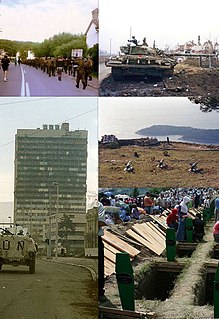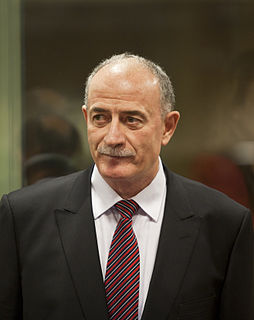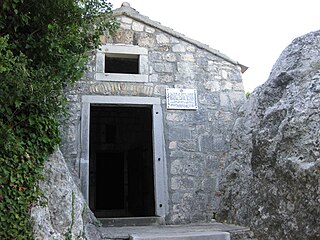Related Research Articles

Stjepan "Stipe" Mesić is a Croatian lawyer and politician who served as President of Croatia from 2000 to 2010. Before serving two five-year terms as president, he was prime minister of SR Croatia (1990) after the first multi-party elections, the last president of the Presidency of Yugoslavia (1991) and consequently secretary general of the Non-Aligned Movement (1991), as well as speaker of the Croatian Parliament (1992–1994), a judge in Našice, and mayor of his hometown of Orahovica.

The Yugoslav Wars were a series of separate but related ethnic conflicts, wars of independence, and insurgencies fought in the former Yugoslavia from 1991 to 2001, leading up to and resulting from the breakup of the Yugoslav federation in 1992. Its constituent republics declared independence due to unresolved tensions between ethnic minorities in the new countries, which fueled the wars. Most of the wars ended through peace accords, involving full international recognition of new states, but with a massive human cost and economic damage to the region.

Momir Bulatović was a Yugoslav and Montenegrin politician. He was the first President of the Republic of Montenegro from 1990 to 1998, after which he served as the Prime Minister of the Federal Republic of Yugoslavia from 1998 until 2000, when Slobodan Milošević was overthrown. He was a leader of the Montenegro's Democratic Party of Socialists from 1989 to 1997, when he split from DPS after a conflict with Milo Đukanović.

In May 1945, after the end of World War II in Europe, during which Yugoslavia had been occupied by the Axis powers, tens of thousands of soldiers and civilians associated with the Axis powers fled Yugoslavia to Austria as the Soviet Union and Yugoslav Partisans took control. When they reached Allied-occupied Austria, the British refused to accept their surrender and directed them to the Partisans instead despite knowing that they would be killed. The prisoners of war were subjected to forced marches, together with columns captured by other Partisans in Yugoslavia. Tens of thousands were executed; others were taken to forced labor camps, where more died from harsh conditions. The events are named for the Carinthian border town of Bleiburg, where the initial repatriation was carried out, hence the Bleiburg repatriations or Bleiburg Tragedy.

Sekula Drljević was a Montenegrin and Yugoslav jurist, politician, orator, and theoretician who was also a war criminal and a collaborator with the Ustaše regime in the Axis puppet state the Independent State of Croatia during World War II.

The Croatian War of Independence was fought from 1991 to 1995 between Croat forces loyal to the Government of Croatia—which had declared independence from the Socialist Federal Republic of Yugoslavia (SFRY)—and the Serb-controlled Yugoslav People's Army (JNA) and local Serb forces, with the JNA ending its combat operations in Croatia by 1992. In Croatia, the war is primarily referred to as the "Homeland War" and also as the "Greater-Serbian Aggression". In Serbian sources, "War in Croatia" and (rarely) "War in Krajina" are used.
The Omarska camp was a concentration camp run by Bosnian Serb forces in the mining town of Omarska, near Prijedor in northern Bosnia and Herzegovina, set up for Bosniak and Croat men and women during the Prijedor massacre. Functioning in the first months of the Bosnian War in 1992, it was one of 677 alleged detention centers and camps set up throughout Bosnia and Herzegovina during the war. While nominally an "investigation center" or "assembly point" for members of the Bosniak and Croatian population, Human Rights Watch classified Omarska as a concentration camp.

Manjača was a concentration camp which was located on mount Manjača near the city of Banja Luka in northern Bosnia and Herzegovina during the Bosnian War and the Croatian War of Independence from 1991 to 1995. The camp was founded by the Yugoslav National Army (JNA) and authorities of the Republika Srpska (RS) and was used to collect and confine thousands of male prisoners of Bosniak and Croat nationalities.

The Trnopolje camp was an internment camp established by Bosnian Serb military and police authorities in the village of Trnopolje near Prijedor in northern Bosnia and Herzegovina, during the first months of the Bosnian War. Also variously termed a concentration camp, detainment camp, detention camp, prison, and ghetto, Trnopolje held between 4,000 and 7,000 Bosniak and Bosnian Croat inmates at any one time and served as a staging area for mass deportations, mainly of women, children, and elderly men. Between May and November 1992, an estimated 30,000 inmates passed through. Mistreatment was widespread and there were numerous instances of torture, rape, and killing; ninety inmates died.
The Vukovar massacre, also known as the Vukovar hospital massacre or the Ovčara massacre, was the killing of Croatian prisoners of war and civilians by Serb paramilitaries, to whom they had been turned over by the Yugoslav People's Army (JNA), at the Ovčara farm southeast of Vukovar on 20 November 1991, during the Croatian War of Independence. The massacre occurred shortly after Vukovar's capture by the JNA, Territorial Defence (TO), and paramilitaries from neighbouring Serbia. It was the largest massacre of the Croatian War of Independence.
The Lora prison camp was a prison camp in Split, Croatia. It was active from 1992 to 1997 with mainly Serbian residents of Split and prisoners of war being imprisoned throughout the Croatian War of Independence. The camp was the site of human rights abuses resulting in a controversial trial, acquittal, retrial and conviction of prison guards. At least 70 inmates were killed over the course of its existence.

Veselin Šljivančanin is a former Montenegrin Serb officer in the Yugoslav People's Army (JNA) who participated in the Battle of Vukovar and was subsequently convicted on a war crimes indictment by the International Criminal Tribunal for the Former Yugoslavia for his role in the Vukovar massacre. His prison sentence was changed twice, from five to seventeen to ten years. He has since been ordered released by the ICTY on time served and good behavior.

The siege of Dubrovnik was a military engagement fought between the Yugoslav People's Army (JNA) and Croatian forces defending the city of Dubrovnik and its surroundings during the Croatian War of Independence. The JNA started its advance on 1 October 1991, and by late October, it had captured virtually all the land between the Pelješac and Prevlaka peninsulas on the coast of the Adriatic Sea, with the exception of Dubrovnik itself. The siege was accompanied by a Yugoslav Navy blockade. The JNA's bombardment of Dubrovnik, including that of the Old Town—a UNESCO World Heritage Site—culminated on 6 December 1991. The bombardment provoked international condemnation, and became a public relations disaster for Serbia and Montenegro, contributing to their diplomatic and economic isolation, as well as the international recognition of Croatia's independence. In May 1992, the JNA retreated to Bosnia and Herzegovina, less than 1 kilometre from the coast in some places, and handed over its equipment to the newly formed Army of Republika Srpska (VRS). During this time, the Croatian Army (HV) attacked from the west and pushed back the JNA/VRS from the areas east of Dubrovnik, both in Croatia and in Bosnia and Herzegovina, and by the end of May linked up with the HV unit defending the city. Fighting between the HV and Yugoslav troops east of Dubrovnik gradually died down.
The Velepromet camp was a detention facility established in the final days of the Battle of Vukovar during the Croatian War of Independence. The camp was set up by the Yugoslav People's Army (JNA), which shared control of the facility with Croatian Serb rebels. The facility, originally an industrial storage site, was located on the southern outskirts of the city of Vukovar, in close proximity to the JNA barracks. It consisted of eight warehouses surrounded by a wire fence, and was established on 16 November 1991, when the first detainees were brought there.

Serbia was involved in the Yugoslav Wars which took place between 1991 and 1999—the war in Slovenia, the war in Croatia, the war in Bosnia and the war in Kosovo. From 1991 to 1997, Slobodan Milošević was the President of Serbia, Serbia was part of the Federal Republic of Yugoslavia (FRY), the International Criminal Tribunal for the Former Yugoslavia (ICTY) has established that Milošević was in control of Serb forces in Bosnia and Herzegovina and Croatia during the wars which were fought there from 1991 to 1995.

Knin camp was a detention camp run by the Krajina Serbian Army in Knin in the puppet state of Republika Srpska Krajina, that held Croatian detainees, soldiers and civilians, from 1991 until 1992, during the Croatian War of Independence. It consisted out of at least two facilities. The ICTY stated that a prison in Knin, run by the Yugoslav People's Army, held approximately 150 detainees, while the old hospital in Knin, run by "Martic's Militia", held approximately 120 detainees. At least two prisoners perished.
The Bučje camp was an internment camp run by rebel Croatian Serb forces during the early stages of the Croatian War of Independence. Located in the village of Bučje near Pakrac, the camp was used for the imprisonment of 200–300 Croatian civilians, prisoners of war, other non-Serbs, as well as Serbs that sided with the Croatian government or refused to join Serbian paramilitary groups. The camp was the site of numerous war crimes including murder, rape and torture. Twenty-two detainees are still listed as missing as of December 2013.
Ovčara was a Serbian transit camp for Croatian prisoners during the Croatian War of Independence, from October to December 1991, and the location of the Ovčara massacre.

The Uprising in Montenegro(Serbo-Croatian: Ustanak u Crnoj Gori / Устанак у Црној Гори), commonly known as the 13 July Uprising(Serbo-Croatian: Trinaestojulski ustanak / Тринаестојулски устанак) was an uprising against Italian occupation forces in Montenegro. Initiated by the Communist Party of Yugoslavia on 13 July 1941, it was suppressed within six weeks, but continued at a much lower intensity until Battle of Pljevlja on 1 December 1941. The insurgents were led by a combination of communists and former Royal Yugoslav Army officers from Montenegro. Some of the officers had recently been released from prisoner-of-war camps following their capture during the invasion of Yugoslavia. The communists managed the organisation and provided political commissars, while the insurgent military forces were led by former officers. The entire nation rejected the privileged position offered by its occupiers, rejected the capitulation in order to fight for Yugoslavia, together with "Russia".
Anti-Croat sentiment is discrimination or prejudice towards Croats as an ethnic group and negative feelings towards Croatia as a country.
References
- ↑ "Suspects in Morinj Case Fail to Appear at Hearing" (in Croatian). Vijesti.hrt.hr. Archived from the original on 2014-01-03. Retrieved 2014-01-03.
- ↑ The Prisoners and the Antagonists are Forgotten Archived July 2, 2007, at the Wayback Machine
- ↑ "Morinj Camp Soon in Front of Prosecutor". Pcnen.com. Retrieved 2014-01-03.
- ↑ adriaticmedia. "Case of Morinj Camp Still in Waiting". Net.hr. Archived from the original on 2007-06-18. Retrieved 2014-01-03.
- ↑ Foto: Arhiva VL/Reuters. "Osuđeni pripadnici bivše JA zbog mučenja zarobljenika". Vecernji.hr. Retrieved 2014-01-03.
- ↑ :.. Liberalna Partija Crne Gore :